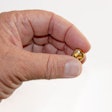
Simple Esthetics with Kerr's Premise Composite Restorative
By Dr. Simona Cuevas
Today's esthetic dentistry aims to replace damaged or malformed tooth structures with artificial materials that have been tested and proven to posses biological, functional and physical properties very similar to natural teeth. The newest generation of nanofilled composite resins offers excellent esthetic potential and great longevity without the need of unnecessary tooth structure removal. The multitude of shades, translucencies, opacities, and available color effects combined with skilled placement techniques almost guarantee incredibly beautiful results which closely mimic natural dentition. Nanofilled composites present similar mechanical and physical properties to those of microhybrid composites, yet their polishablity and gloss retention surpass all other known composites. One example of a cosmetic nanofilled composite is Premise by Kerr Corporation.
Traditional restorative objectives have not changed over time. They were simply implemented based on the esthetic demands of an increasing number of patients. Composite resins have become the material of choice for conservative, esthetic restorative approaches. The contemporary practitioner is ultimately challenged to replace missing or esthetically inadequate tissues or to modify their configuration by applying on the patient's teeth an artificial material, which must simulate the appearance of natural tissues. The natural layering concept together with an overall esthetic approach has enabled the achievement of this objective in a predictable way. Esthetic dentists have long advocated the freehand placement of various opacious, body, and translucent composite materials onto the air-inhibited layer of a previously cured increment. It is the presence of a 3-µm to 5-µm layer of unpolymerized resin on the surface that provides the organic coupling sites for the additional increments. While layering composites in this fashion is optimal, the complexities of predetermining the exact thickness, placement, and shape of each layer and opacity complicate freehand layering.
Case Presentation
A 25-year-old female patient presented with a darkly stained class 4 composite on tooth #8.
Post-op close-up
It is my firm belief that by using well-tested modern restorative materials [like Premise] and implementing proper diagnosis, even with only moderate skill level, any dentist can achieve extraordinary esthetic results with minimal chair time.
Read the full article on Dentalcompare.com
Learn more about Premise Universal Nanohybrid Composite















